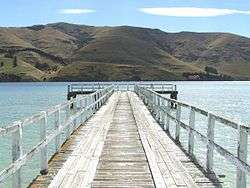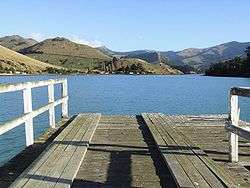Port Levy
Port Levy (Māori: Koukourarata) is a long, sheltered bay and settlement on Banks Peninsula in Canterbury, New Zealand. The current population is under 100, but in the mid-19th century it was the largest Māori settlement in Canterbury with a population of about 400 people. It is named after Solomon Levey, an Australian merchant and ship owner who sent a number of trading vessels to the Banks Peninsula area during the 1820s.


The bay was settled by the Ngai Tūāhuriri sub-tribe of Ngāi Tahu, and the chief Moki named the bay "Koukourarata" after a stream in Wellington that recalls the birth of his father, Tu Ahuriri. It was also the home of Tautahi, the chief after whom the swampland area Ōtautahi was named – now the site of the city of Christchurch.
Koukourarata marae, a marae (tribal meeting ground) of Ngāi Tahu and its Te Rūnanga o Koukourarata branch, is located at Port Levy.[1] It includes the Tūtehuarewa wharenui (meeting house).[2] The first Māori Anglican church was built at Port Levy and a stone memorial marks the site.
Portions of the Peter Jackson film Heavenly Creatures were shot in Port Levy — specifically the scenes where Pauline Parker and Juliet Hulme, two 16-year-old girls from Christchurch, saw their imaginary Fourth World.
See also
References
- "Te Kāhui Māngai directory". tkm.govt.nz. Te Puni Kōkiri.
- "Māori Maps". maorimaps.com. Te Potiki National Trust.